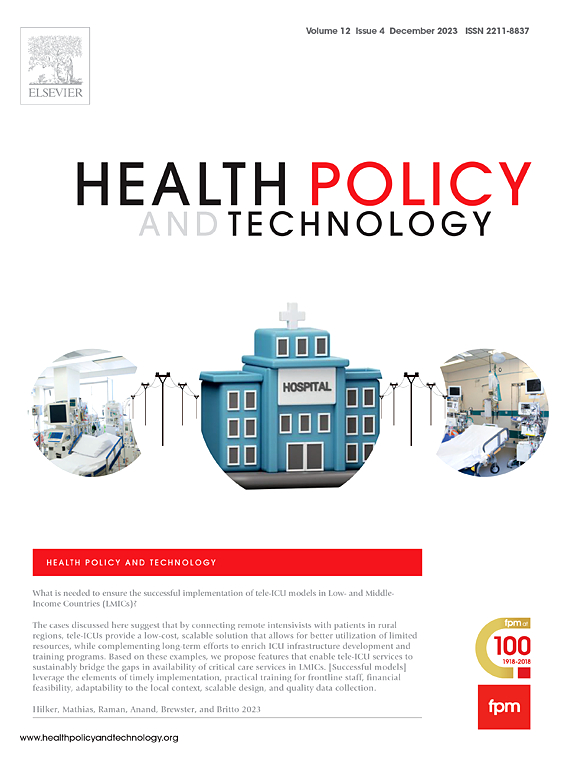Computer assisted history taking in elective and acute care: Systematic review
IF 3.7
3区 医学
Q1 HEALTH POLICY & SERVICES
引用次数: 0
Abstract
Background
Computer-assisted history taking (CAHT) could increase patient flow efficiency and healthcare resources optimization. By assessing reported clinical and patient-reported outcomes, we can clarify the benefits, limitations, and practical considerations of CAHT in clinical care. This systematic review synthesizes literature on CAHT in acute and elective care.
Methods
This systematic review followed PRISMA guidelines. A comprehensive search of MEDLINE, Embase, CINAHL, and Web of Science identified studies published between January 2014 and December 2024. Two reviewers independently screened articles, assessed study quality, and extracted data narratively.
Results
In total, 19 studies (involving 11,885 unique patients and 151 healthcare providers) were included. CAHT-questionnaire completion rates were high (75–95%) in larger samples but lower (51–67%) in smaller ones. Satisfaction was consistently high across different delivery methods and devices. Positive outcomes on patient engagement, such as active involvement and enhanced communication, were demonstrated. Clinical efficiency did improve in terms of streamlined workflows and resource utilization. Mixed results were reported on consultation duration. Finally, improved diagnostic accuracy was reported through comprehensive data capture and better alignment with clinical standards.
Conclusion
CAHT offers opportunities to contribute to patient engagement, workflows, and diagnostic accuracy, with high completion rates. We need sound implementation studies to explore how CAHT-systems can streamline processes and minimize needed resources. Future implementations should ensure integration into electronic health records and address digital inclusion across age groups and regions to realize CAHT’s potential in routine, patient-centered care.
计算机辅助择期和急症护理的病史记录:系统回顾
计算机辅助历史记录(CAHT)可以提高患者流程效率并优化医疗资源。通过评估报告的临床和患者报告的结果,我们可以澄清临床护理中CAHT的益处、局限性和实际考虑。本系统综述综合了CAHT在急性和择期护理方面的文献。方法本系统评价遵循PRISMA指南。对MEDLINE, Embase, CINAHL和Web of Science进行全面搜索,确定了2014年1月至2024年12月之间发表的研究。两位审稿人独立筛选文章,评估研究质量,并以叙述方式提取数据。结果共纳入19项研究,涉及11,885名特殊患者和151名医护人员。caht问卷完成率在较大样本中较高(75-95%),而在较小样本中较低(51-67%)。在不同的交付方式和设备中,满意度始终很高。患者参与的积极结果,如积极参与和加强沟通,被证明。在简化工作流程和资源利用方面,临床效率确实有所提高。关于咨询时间的报告结果好坏参半。最后,通过全面的数据采集和更好地符合临床标准,提高了诊断的准确性。结论caht提供了促进患者参与、工作流程和诊断准确性的机会,并具有高完成率。我们需要进行合理的实施研究,以探索caht系统如何简化流程并最大限度地减少所需资源。未来的实施应确保整合到电子健康记录中,并解决跨年龄组和地区的数字包容问题,以实现CAHT在以患者为中心的常规护理中的潜力。
本文章由计算机程序翻译,如有差异,请以英文原文为准。
求助全文
约1分钟内获得全文
求助全文
来源期刊

Health Policy and Technology
Medicine-Health Policy
CiteScore
9.20
自引率
3.30%
发文量
78
审稿时长
88 days
期刊介绍:
Health Policy and Technology (HPT), is the official journal of the Fellowship of Postgraduate Medicine (FPM), a cross-disciplinary journal, which focuses on past, present and future health policy and the role of technology in clinical and non-clinical national and international health environments.
HPT provides a further excellent way for the FPM to continue to make important national and international contributions to development of policy and practice within medicine and related disciplines. The aim of HPT is to publish relevant, timely and accessible articles and commentaries to support policy-makers, health professionals, health technology providers, patient groups and academia interested in health policy and technology.
Topics covered by HPT will include:
- Health technology, including drug discovery, diagnostics, medicines, devices, therapeutic delivery and eHealth systems
- Cross-national comparisons on health policy using evidence-based approaches
- National studies on health policy to determine the outcomes of technology-driven initiatives
- Cross-border eHealth including health tourism
- The digital divide in mobility, access and affordability of healthcare
- Health technology assessment (HTA) methods and tools for evaluating the effectiveness of clinical and non-clinical health technologies
- Health and eHealth indicators and benchmarks (measure/metrics) for understanding the adoption and diffusion of health technologies
- Health and eHealth models and frameworks to support policy-makers and other stakeholders in decision-making
- Stakeholder engagement with health technologies (clinical and patient/citizen buy-in)
- Regulation and health economics
 求助内容:
求助内容: 应助结果提醒方式:
应助结果提醒方式:


